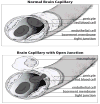Cerebral microbleeds in the elderly: a pathological analysis
- PMID: 21030702
- PMCID: PMC3079284
- DOI: 10.1161/STROKEAHA.110.593657
Cerebral microbleeds in the elderly: a pathological analysis
Abstract
Background and purpose: Cerebral microbleeds in the elderly are routinely identified by brain MRI. The purpose of this study was to better characterize the pathological basis of microbleeds.
Methods: We studied postmortem brain specimens of 33 individuals with no clinical history of stroke and with an age range of 71 to 105 years. Cerebral microbleeds were identified by presence of hemosiderin (iron), identified by routine histochemistry and Prussian blue stain. Cellular localization of iron (in macrophages and pericytes) was studied by immunohistochemistry for smooth muscle actin, CD68, and, in selected cases, electron microscopy. Presence of β-amyloid was analyzed using immunohistochemistry for epitope 6E10.
Results: Cerebral microbleeds were present in 22 cases and occurred at capillary, small artery, and arteriolar levels. Presence of microbleeds occurred independent of amyloid deposition at site of microbleeds. Although most subjects had hypertension, microbleeds were present with and without hypertension. Putamen was the site of microbleeds in all but 1 case; 1 microbleed was in subcortical white matter of occipital lobe. Most capillary microbleeds involved macrophages, but the 2 microbleeds studied by electron microscopy demonstrated pericyte involvement.
Conclusions: These findings indicate that cerebral microbleeds are common in elderly brain and can occur at the capillary level.
Figures




Comment in
-
Letter by Charidimou and Werring regarding article, "Cerebral microbleeds in the elderly".Stroke. 2011 Apr;42(4):e368. doi: 10.1161/STROKEAHA.110.609040. Epub 2011 Feb 17. Stroke. 2011. PMID: 21330630 No abstract available.
References
-
- Vernooij MW, van der Lugt A, Ikram MA, Wielopolski PA, Niessen WJ, Hofman A, Krestin GP, Breteler MMB. Prevalence and risk factors of cerebral microbleeds: The Rotterdam Scan Study. Neurology. 2008;70:1208–1214. - PubMed
-
- Lee SH, Ryu WS, Roh JK. Cerebral microbleeds are a risk factor for warfarin-related intracerebral hemorrhage. Neurology. 2009;72:171–176. - PubMed
-
- Vernooij MW, Haag MD, van den Lugt A, Hofman A, Krestin GP, Stricker BH, Breteler MM. Use of antithrombotic drugs and the presence of cerebral microbleeds: the Rotterdam Scan Study. Arch Neurol. 2009;66:714–720. - PubMed
-
- Schrag M, McAuley G, Pomakian J, Jiffry A, Tung S, Mueller C, Vinters HV, Haacke EM, Holshouser B, Kido D, Kirsch WM. Correlation of hypointensities in suspectibility-weighted images to tissue histology in dementia patients with cerebral amyloid angiopathy: a post-mortem MRI study. Acta Neuropathol. 2009 Nov 25; (Epub ahead of print) - PMC - PubMed
-
- Greenberg SM. Cerebral amyloid angiopathy: Prospects for clinical diagnosis and treatment. Neurology. 1998;51:690–694. - PubMed
Publication types
MeSH terms
Grants and funding
LinkOut - more resources
Full Text Sources
Other Literature Sources

